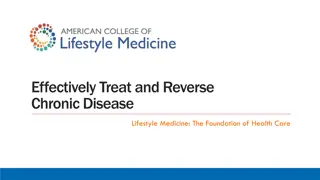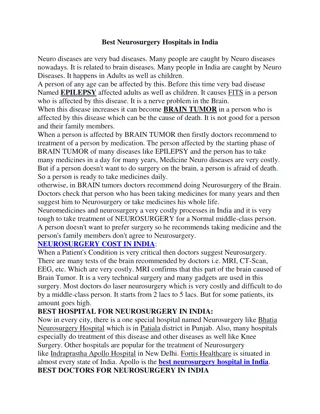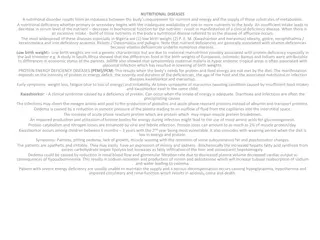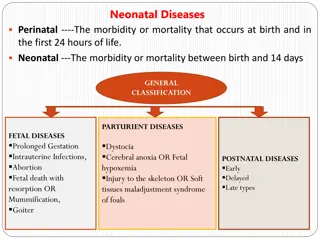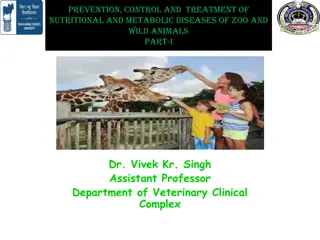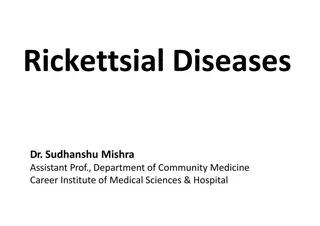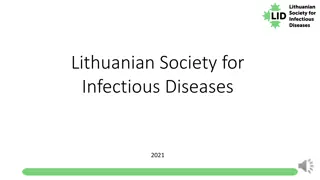The Impact of Lifestyle Diseases
Lifestyle diseases, also known as diseases of longevity or diseases of civilization, are on the rise as countries industrialize and people live longer. These diseases include type 2 diabetes, heart disease, obesity, and more. They are often preventable with changes in diet, environment, and lifestyle. Developmental origins of health and disease highlight the importance of early nutrition and growth on long-term health outcomes, linking chronic diseases to fetal and childhood development. Sedentary lifestyles worsen the situation, leading to a global burden of noncommunicable diseases.
Download Presentation

Please find below an Image/Link to download the presentation.
The content on the website is provided AS IS for your information and personal use only. It may not be sold, licensed, or shared on other websites without obtaining consent from the author.If you encounter any issues during the download, it is possible that the publisher has removed the file from their server.
You are allowed to download the files provided on this website for personal or commercial use, subject to the condition that they are used lawfully. All files are the property of their respective owners.
The content on the website is provided AS IS for your information and personal use only. It may not be sold, licensed, or shared on other websites without obtaining consent from the author.
E N D
Presentation Transcript
Lifestyle diseases Lifestyle diseases (diseases of longevity or diseases of civilization) - increase in frequency as countries become more industrialized and people live longer. These include type 2 diabetes, heart disease, metabolic syndrome, obesity, atherosclerosis, chronic renal failure, osteoporosis, stroke, depression. Also includes Alzheimer's disease, asthma, COPD, and cirrhosis
Lifestyle diseases They are relationship environment caused by an inappropriate of people with their Onset develop, and once encountered are difficult cure is insidious, they take years to Potentially can be prevented by changes in diet, environment, and lifestyle
( 1 ) . . Development plasticity . .
( 2 ) Developmental origins of health & disease (DoHad) Developmental plasticity : . - . . . ) (
Developmental Origins of Health and Disease (DOHaD) Chronic disease outcomes have their roots in fetal and early childhood development The world faces a crisis of increasing chronic diseases reduction of health and welfare and increased financial burden of NCDs This includes obesity, type 2 DM, insulin resistance, dyslipidemia, CVD and atherosclerotic disease They are seen at a younger age as chronic disorders in childhood and adolescents Serves as a framework to assess the effect of early nutrition and growth on long-term health
Global Deaths According to Cause and Sex, 2008 Hunter DJ. N Engl J Med 2013; 369: 1336
Proportion of Deaths from Noncommunicable Diseases among Persons Younger than 60 Years of Age, According to Income Group of Countries Hunter DJ. N Engl J Med 2013; 369: 1336
WHO 2012 World Health Statistics (CVD) accounts for the majority of death from NCDs, causing 17 million deaths in 2008, or nearly half of all reported cases, and it is expected that by 2030, CVD death will reach 28 million. Cancer (21%), respiratory disease (12 %), and diabetes (3.5%) Curr Hypertens Rep (2012) 14:475 477.
WHO 2012 World Health Statistics the probability of dying from an NCD during prime working years of 30 to 70 years of age is nearly two-fold higher (48 % vs. 26 %) in low-income and middle- income countries compared to wealthier nations. In addition, 80 % of all NCD deaths overall occurred in the lowest income nations. The problem for these nations, therefore, is huge. Curr Hypertens Rep (2012) 14:475 477.
In contrast to hypertension, which showed overall worldwide improvement, the WHO Report notes concerning observations on metabolic syndrome and diabetes, which has been well correlated with obesity. According to the WHO report, obesity rose from 5 % to 10 % in men worldwide, and from 8 % to 14 % in women. As reported elsewhere, during this same time frame, worldwide diabetes prevalence rose from 8.3 % and 7.5 % in men and women, respectively, in 1980, to 9.8 % and 9.2 % in 2008. Curr Hypertens Rep (2012) 14:475 477.
Associations between poverty, non-communicable diseases (NCDs), and development goals MDG=Millennium Development Goal Curr Hypertens Rep. 2012; 14(6):475-7.
Five priority actions by countries and international agencies for the non-communicable disease (NCD) crisis Curr Hypertens Rep. 2012; 14(6):475-7.
Prevention of NCD Focus on behavioural change as the core component of all clinical programmes for the prevention and management of chronic disease. Establish actual centres to design, implement, study and improve preventive programmes for chronic disease. Use human-centred design in the creation of prevention programmes with an inclination to action, rapid prototyping and multiple iterations. Extend the knowledge and skills of Sports and Exercise Medicine professionals to build new programmes for the prevention and treatment of chronic disease. Mobilise resources and leverage networks to scale and distribute programmes of prevention. Br J Spoorts Med. 2013; 47(16):1003-11.
Most of the interventions advocated by WHO are nothing to do with doctors and health systems. Most of what needs to be done to counter NCDs lies outside the health systems. We have strong evidence that we can prevent prediabetes and prehypertension progressing to the full blown conditions by helping people change their lifestyles and lose weight. Again, this is nothing to do with doctors and drugs. The programmers are unaffordable if they use doctors rather than community health workers. BMJ .2011; 343
During the last decades, the incidence of NCDs increased worldwide and Population Based Cohort Studies designed to determine the risk factors of these diseases especially CVDs
Prospective Studies of Cardiometabolic Disease and Risk Factors Framingham Heart Study in US (1948) Puerto Rico Heart Health program (1965) Bogalusa Heart Study in US (1972) Honolulu Heart Program among Japanese Americas (1980) MONICA (multinational Monitoring of trends and determinants in Cardiovascular isease) in 21 countries (1980) ARIC (Atherosclerosis Risk in Communities Study) in four US communities (1987) CHS (Cardiovascular Health Study) in US (1989) SHS (Strong Heart Study) in America Indians (1989) Rotterdam Study in the Netherlands (1990) AusDiab (Austrailian Diabetes, Obesity and Lifestyle Study) (1999) TLGS (Tehran Lipid and Glucose Study) in Iran (1999)
TC, BMI and SBP trends in Iran between 1980 and 2008 TC BMI SBP 6.0 30 140 5.6 28 135 Male mmol/L 5.2 26 130 kg/m^2 mmHg 4.8 24 125 4.4 22 120 4.0 20 115 1980 1990 2000 2010 1980 1990 2000 2010 1980 1990 2000 2010 140 6.0 30 135 5.6 28 Female 130 mmHg kg/m^2 5.2 26 mmol/L 125 4.8 24 120 4.4 22 115 4.0 20 1980 1990 2000 2010 1980 1990 2000 2010 1980 1990 2000 2010 Farzadfar et al. Lancet 2011, Finucane et al. Lancet 2011, Danaei et al. Lancet 2011
1375 TLGS 1377 ) ( 1379 : 1379 1380 TLGS ( ) TLGS 1381 ) ( 1381 1382 1383 (TLGS) 1384 (TLGS) 1387
Global response to non-communicable disease The authors are principal investigators and other researchers in a network of centers of excellence in low and middle income countries conducting research into non-communicable disease. These authors comprise Maria Terease Cerqueria (Mexico), Alejandro Cravioto (Bangladesh), Nancy Dianis (US), Hassen Ghannem (Runisia) .. BMJ. 2011 Jun 30;342:d3823



